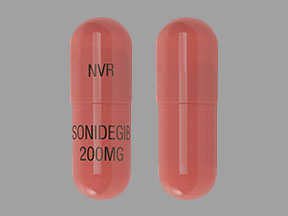Sonidegib and Alcohol/Food Interactions
There is 1 alcohol/food/lifestyle interaction with sonidegib.
Sonidegib Food
Moderate Food Interaction
Sonidegib should be taken on an empty stomach, at least 1 hour before or 2 hours after a meal. The presence of food can significantly increase the absorption of sonidegib into the blood stream. This may increase side effects such as muscle spasms, muscle pain, muscle weakness, fatigue, nausea, vomiting, diarrhea, loss of appetite, weight loss, hair loss, itching, and taste abnormalities. You may also have an increased risk of developing a rare but serious condition called rhabdomyolysis that involves the breakdown of skeletal muscle tissue. In some cases, rhabdomyolysis can cause kidney damage and even death. Let your doctor know immediately if you have unexplained muscle pain, tenderness, or weakness during treatment with sonidegib, especially if these symptoms are accompanied by fever or dark colored urine. Grapefruit juice may also increase the blood levels of sonidegib and should be avoided. Talk to your doctor or pharmacist if you have any questions or concerns.
Sonidegib drug interactions
There are 176 drug interactions with sonidegib.
Sonidegib disease interactions
There are 2 disease interactions with sonidegib which include:
More about sonidegib
- sonidegib consumer information
- Check interactions
- Compare alternatives
- Reviews (1)
- Side effects
- Dosage information
- During pregnancy
- Drug class: hedgehog pathway inhibitors
- Breastfeeding
- En español
Related treatment guides
Drug Interaction Classification
| Highly clinically significant. Avoid combinations; the risk of the interaction outweighs the benefit. | |
| Moderately clinically significant. Usually avoid combinations; use it only under special circumstances. | |
| Minimally clinically significant. Minimize risk; assess risk and consider an alternative drug, take steps to circumvent the interaction risk and/or institute a monitoring plan. | |
| No interaction information available. |
Further information
Always consult your healthcare provider to ensure the information displayed on this page applies to your personal circumstances.


